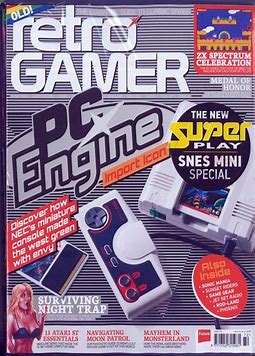Statement of Intent –
For my gaming magazine I am going to prioritize the genre of retro gaming; supporting consoles such as Commodore 64, Nintendo 64 and NES (Nintendo Entertainment System). My magazine is predominantly aimed at a younger male audience around the age of 11 as the dominant ideology suggests they are more likely to be interested in war/ Sci-fi related games, they are also mainstreamers, this is because due to their age – they’re more likely to follow the ‘trend’ and what they think is ‘cool’.
The genre of my magazine is retro, and this will be represented as the magazine will include promotions of 8-bit characters acting as an indexical sign for the genre, interactive quizzes related to retro games characters/ retro games and a plug referring supporting a playlist containing tunes/ songs from popular retro games.
The style of language that I will use is a mix of informal and formal because I want the magazine to seem professional and be factual in relation to its contents but I also want it to appeal to my target audience by using more colloquial language they would use in an everyday life so that they can relate to it and use the magazine as a form of escapism, interlinking with the uses and gratification theory.
In addition, I will also use the san-serif font – ‘Acumin Variable Concept’ – for my masthead as it is fairly blocky therefore portraying quite a retro effect. As well as this, I will also use a sans-serif font for the selling line as it emphasises its importance. This font style isn’t formal, therefore more eye-catching to a younger male audience.
When creating the actual foundations of the magazine cover, I am going to use the tabloid size which Photoshop generated. With a width of – 27.94 CM and a height of – 43.18 CM. I will use this size as the majority of gaming magazines released in the 80’s would have been a similar size – just below A4.
As well as this, I am also going to layout my plugs/ advertisements along the bottom of the page in order to make the overall magazine structured by using lines and columns to separate each one, similar to the style model I have chosen which adds depth to the magazine due to the depth of field caused by the lines and boxes between the plugs and the actual front cover. In order to increase the authenticity of the magazine, there will be a ‘New!’ sign in the top left to act as a signifier to show the intended viewer that this is the latest realised version of the magazine. In addition, the use of text throughout the plugs also acts as anchorage; supporting other similar games/ magazines.
Representation –
In some respects, my magazine cover can be veiwed as a radical text as modern games which are ‘popular’ today don’t tend to be retro or 8-bit style. The dominant signifier of the magazine – the 8-bit soldier character can be seen in camo trousers, holding a gun. Therefore, this magazine cover could also be portrayed as a reactionary text as the main genre – action/ thriller follows the dominant ideology of having a male lead who is carrying some sort of defence (the gun) not commonly associated with women.
As well as this, a dull/ dark colour scheme has been followed which therefore aims the magazine to a male audience due to the stereotype of males not commonly opting for bright or neon colours due to it’s link with femininity.
In addition, aother reason which supports this text being reactionary would be how covered or plain the main character is due to his gender. Whereas if the main character was female, the dominant ideology would be to have her clothes be slightly more revealing and her body to be slightly more emphasised in order to sexualise/ objectify her to appeal to the standard male audience.
Audience Theories –
Reception Theory – Stuart Hall – Suggests that media texts are encoded and decoded; the producer encodes messangs and/ or values into their media which is then decoded by the audience or viewer/s.
Cultivasion Theory – George Gerbner – This theory suggests that over time, exposure to media can cultivate/ change a veiwers attitude or opinion towards different subjects. Frequent television viewers are more likely to be ‘exposed’ to their perceptions of reality being changed (for better or worse) / become reflective of the most common messaged which are advertised.
Theory Of Preferred Reading – when the audience rejects the preferred reading, and creates their own meaning for the text – An oppositional View. Negotiated Reading – This is when a member of the audience partly agrees with part of the product.
Style Models –
My Magazine Cover –



